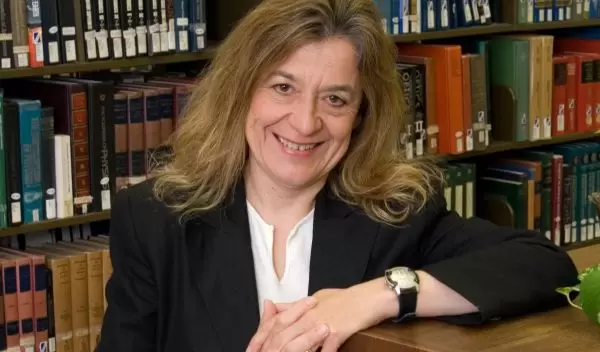
After the Lecture: Anna Balazs
We sat down with the University of Pittsburgh's Anna Balazs after her recent talk on "Designing Materials That Compute," as part of the National Science Foundation's Distinguished Lectures in Mathematical and Physical Sciences. The conversation moved quickly from her experiences as an immigrant who escaped the Hungarian revolution to her own inspirations for being a scientist, and how smart girdles might very well be a thing of the future.
In '56, there was a Hungarian revolution where the Russian troops came in, much like in '68 in Czechoslovakia. My parents were Holocaust survivors, and they didn't want to go through this again. So my mother said to my dad, "We have to escape; this is not the life for our child."
My father was a veterinarian, so he planned an escape route where we would stop off at other veterinarians' houses on New Year's Eve when he knew that the soldiers would be drunk. I was 3, and we walked and we walked. I remember hiding in haystacks.
There's something about immigrants and the stories they tell their children and how they want them to succeed. It's a very powerful lesson: Coming with nothing, they want their children to be able to stand on their own feet and survive. For that generation of immigrants, education was the route to survival.
There are women of a certain generation--my generation--who were inspired to do science by their parents. If you ask a woman my age what prompted her to go into science, she invariably tells you it was her dad.
My father would listen to recordings of heartbeats so he could train his ear to hear the irregularities. As a toxicologist, he wanted to see how a particular drug, when administered to an animal, might change the heartbeat. So he had to train his ear. There was this record of heartbeats, and he would listen to it passionately as if listening to music. I was just enamored with the dedication and his desire to do it correctly.
He talked about his work in such a passionate way, yet all the time saying, "You can't be a scientist." I had to have a shingle. Who hangs out shingles? Well, physicians.
I look for stories. I am interested in biomimetic materials--materials that imitate biology. I look at biology as a story. At the moment, I'm in love with amphibians. If they lose their little limbs, they simply grow new ones. So we try to make a material that does a similar thing. I look at biology as a source of inspiration--a source of metaphors.
How do people fall in love with a discipline? Perhaps it's not that dissimilar with falling in love with a person. When I heard about materials science, it just seemed cool to me because it had chemistry, it had physics and it had making something.
A useful thing to think about in the aging population is how to help quality of life. Wouldn't it be wonderful if you could wear clothes that could sense a problem--like a biosensor? But then they'd go the next step. And they'd correct it for you. So you could wear a piece of clothing, and it could detect you're not walking all that well, right now. Maybe you have a weakness in a joint--in a hip. It would autonomously recognize the pattern that your motion has changed. And then--again autonomously--put a liiiiiiitle bit more pressure on one side--like a smart girdle that can fix your gait but doing it all autonomously. It would be a biosensor and a corrector.
I had this wonderful thesis adviser, George Whitesides, who'd say, "Ms. Balazs, what are the 10 most important problems in science, and why are you not working on them?"
One of the best pieces of advice I ever got was if you submit a grant and it gets rejected, pick yourself up and submit it a second time. If it gets rejected again, it's that person who picks themselves up a third time and resubmits it--they're going to succeed. Persistence. You have to have persistence. You have to develop a thick skin.
Lack of funding for an idea you think is brilliant is always hard.
Jane Goodall. She was on "National Geographic." There she was: blonde, beautiful and a brilliant scientist. She was young. She was passionate. She was dedicated. She was everything.
If I couldn't be a scientist, I'd be a writer. Part of the joy of doing science is the writing of the science. The act of writing helps you clarify your thoughts.
When I was a child my favorite toy was plasticine. Like Play-Doh, you shaped it into some form, put it in the oven to bake, and it came out as the thing you shaped it as. That was my favorite thing.
Even before Play-Doh, I played with mechanical pencils. Apparently I did this even as a kid. My father, even when we were still living in Hungary would buy these beautiful mechanical pencils. He was a great dad, but he wouldn't let me play with them. Of course, I did and obviously would break them.
To relieve tension, I go sculling--rowing long, narrow boats. There's an enormous endorphin rush when you scull. People get it in different ways. I get it in a very tactile way. I taste. I taste amazing green peppers, fabulous coffee, wonderful French fries and #2 pencils. I remember the taste of chewing on a #2 pencil. I always loved pencils and drawing. And I think that that did lead to wanting to play with numbers and doing math.
There was a brilliant, brilliant show that interviewed women in science, including a young astrophysicist or high energy particle physicist. Her work was very equipment-based research that involved large sums of money. When they asked her, "What would you do if you couldn't have the funding," she replied, "I'd rob a bank! I can't not do this."


